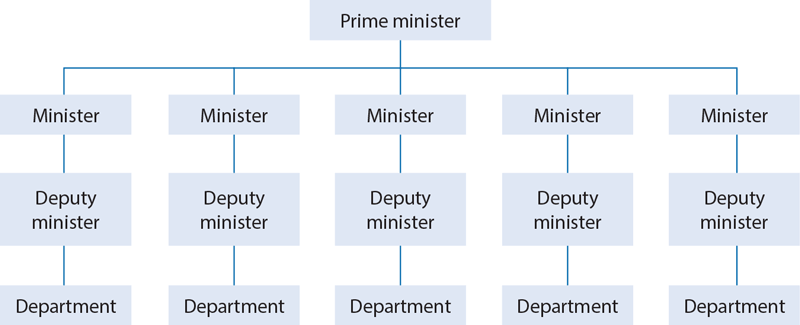White Paper: The Departmentalized Cabinet System
In a departmentalized cabinet system, each minister is officially responsible for his or her own departmental administration and policy development. Each department functions on its own, without formal organizational links to any other (see Figure 4.2). Policy making is largely incremental, a series of small and discrete initiatives to address new concerns and opportunities as they arise while remaining committed to past practices. There is little long-range planning, as each department addresses only matters it considers important, case by case, learning by experience which initiatives best suit its interests and the needs of its clientele. Cabinet itself possesses few, if any, policy coordinating institutions, enabling its members to develop a coherent and systematic approach to policy and program development across the entire government. The prime minister and closest advisers are the only cabinet members who are informed of all pending initiatives, and the prime minister alone is responsible for the coordination, planning, and timing of new undertakings and related decision making.
Figure 4.2: The Departmentalized Cabinet System

Ministers and their departments were thus fairly autonomous. The flow of authority with respect to policy development was from the bottom up, in that it was initiated by departments and their senior officials. Full cabinet met to discuss new proposals, but the sponsoring minister and department were usually accorded the widest possible latitude because they were considered to have bureaucratic expertise in the policy field under discussion. So long as a minister could gain the support of the prime minister, full cabinet approval was almost a certainty (Dunn 2002, 311–12, 316–18; Dyck 2008, 544–48).
This system placed great authority in the hands of the prime minister, of course, as is always the case in a parliamentary system of government, but it is also noteworthy that departmentalized organization sometimes led to the emergence of strong ministers and always to the significant participation of deputy ministers in the policy-making process.
The relative autonomy inherent in a departmentalized system allowed a cabinet minister who was exceptionally talented, hard-working, administratively capable, and politically savvy to become very influential. Some ministers who served in the same portfolio over an extended period became almost synonymous with its policy field. In the governments of William Lyon Mackenzie King and Louis St. Laurent, for example, Jimmy Gardiner of Saskatchewan served as minister of agriculture for 22 years, while C.D. Howe, from Ontario, became closely tied to the fields of finance and industry, gaining the epithet “minister of everything” (Bakvis and MacDonald 1993, 53). Such strong ministers often carved out responsibilities for themselves as cabinet representatives for their regions, dispensing patronage and benefits to the party faithful and providing the communication link between the region and the prime minister and cabinet. Ernest Lapointe, for example, who became Mackenzie King’s Quebec lieutenant, served him faithfully from 1921 to 1941 while also acting as chief advocate for that province’s interests in cabinet. With his death in 1941 this role devolved to St. Laurent.
But not all ministers could be strong figures within cabinet; the talent was rare and the competition fierce. Most ministers in the era of the departmentalized cabinet were in fact not particularly strong even within their own departments, and the tenure of those less skilled than average was often weak and problematic. In all instances, however, deputy ministers rose to prominence in this system. And when the minister proved to be a less than commanding figure, the deputy became, de facto, the most important person in the department, informally eclipsing the de jure authority and prestige of the minister.
A deputy who spent his or her entire public service career within one department, climbing over the decades into more senior positions (as was not uncommon), became intimately knowledgeable about its programs and clientele, its interests, and its policy field. Such a person became, quite naturally, the most worthwhile and influential adviser to each and every minister served. The deputy would help a strong minister become even stronger while assuming the burden of routine administration. And with a less capable minister, the deputy would be left in charge of policy ideas and undertakings as well. In either case, deputy ministers came to be such a pivotal part of the bureaucracy that by the end of World War II, observers of the federal government were referring to them as mandarins—after the mandarins of imperial China, who were the formal bureaucratic (and often the informal political) power behind the throne.
By the 1960s, that influence and power led to questions about the democratic legitimacy of the departmentalized system (Bakvis and MacDonald 1993, 54–55; Dyck 2008, 544–45).
